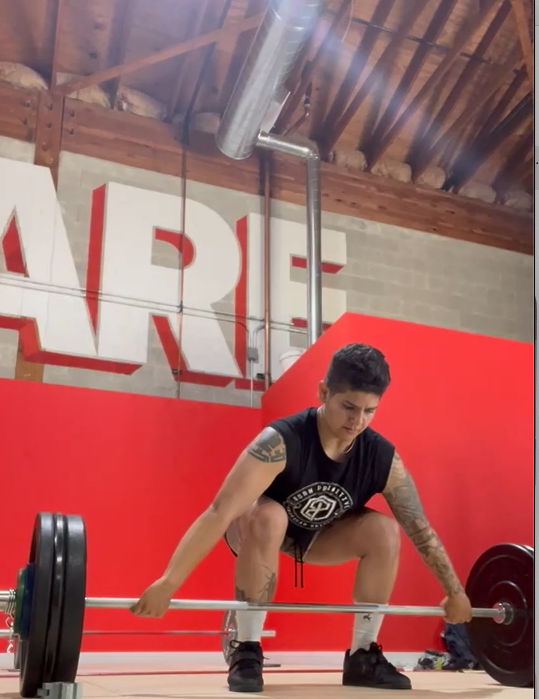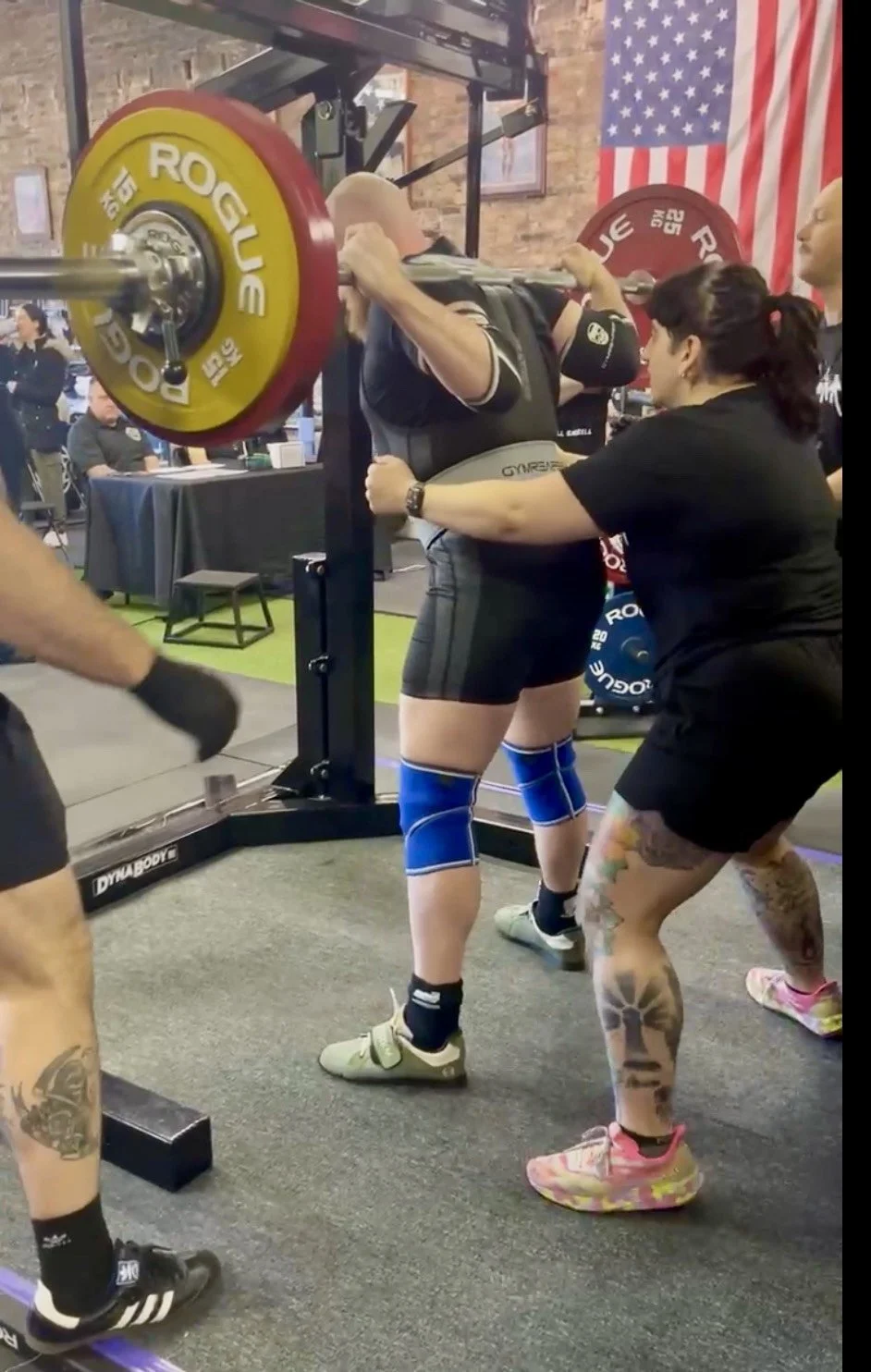The Science Behind Powerlifting vs Olympic Lifting
All types of strength training are beneficial.
But if you want to develop maximal strength or explosiveness, two strength sports stand above the rest.
Olympic weightlifting and powerlifting require a unique blend of physical and mental fortitude. That makes them highly transferable to athletics, fitness, and life.
While both sports involve heavy barbell training and require exceptional physical conditioning, they represent fundamentally different approaches to developing human strength and power.
Athletes, coaches, and fitness enthusiasts must understand these distinctions to maximize their training plans.
Olympic Lifting vs. Powerlifting: The Movements
The main distinction between these two strength sports lies in their specific competition movements.
In Olympic Lifting, both movements begin from the floor and require explosive power to get to the bar to its final position.
Powerlifting consists of three lifts: the squat, bench press, and deadlift. Powerlifting competitions test maximal strength, or the ability to lift the heaviest weight possible for a single repetition. A lifter's total score is simply the total of their best lift across three attempts in each movement.
The three lifts use very different motions.
Olympic lifting consists of the jerk and the clean & snatch. Lifters also earn a score that's a total of their two best attempts. The only difference is that there are six total attempts instead of nine in weightlifting competitions.
While both lifting styles are commonly associated with competitive sports, anyone can incorporate these movements into their fitness routine.
In fact, research increasingly shows the unique advantages of building strength using barbells for lifting heavy weight.
Powerlifting is characterized by different movement patterns that occur with slower reps in order to control heavier weights.
Biomechanical and Movement Pattern Analysis
Research reveals significant biomechanical differences between these disciplines.
However, let's begin with a straightforward explanation of the movement patterns.
Powerlifting requires three distinct starting and ending positions.
The squat is performed by loading the bar on your back and lowering yourself until your knees are just below the hip crease, then returning to the standing position.
The bench press has the lifter lying flat, unracking the bar from above the head, and then bringing the bar to the chest before pushing back up to a straightened arm position.
The deadlift requires a lifter to bring the barbell from the ground to an upright position with knees fully extended.
By contrast, the two Olympic movements both require lifting a barbell from the floor to an overhead position. The snatch involves lifting the bar overhead in one continuous motion. The clean and jerk is performed in two distinct phases: bringing the bar to the shoulders (clean), pressing it overhead (jerk).
Here are other key distinctions:
Olympic lifts are characterized by explosive, multi-planar movements that engage the entire kinetic chain
Olympic weightlifters generate some of the highest peak power outputs recorded in sports literature. Elite athletes can produce over 3,600 watts during the second pull of the snatch.
Powerlifters, conversely, perform reps at slower, more controlled tempos with primary movement occurring in the sagittal plane.
Powerlifts maximize force production rather than power output, with movements typically performed at velocities significantly lower than Olympic lifts.
One study found that the bench press generates approximately 300 watts of power, while the squat and deadlift produce around 1,100 watts.
In summary, powerlifters focus on maximum force production. Olympic lifters focus on peak power output. This fundamental difference reflects the distinct training adaptations each sport promotes.
Training Adaptations and Physiological Responses
Muscle Fiber Recruitment and Neural Adaptations
The different movement velocities and power demands create distinct physiological adaptations.
Olympic lifting predominantly targets fast-twitch muscle fibers through explosive, high-velocity contractions
Research indicates that Olympic lifts enhance neuromuscular efficiency and improve the nervous system's ability to coordinate complex movement patterns.
Powerlifting training primarily develops maximal force production capacity through high-load, low-velocity movements
Studies show that powerlifting training leads to significant increases in maximal strength across multiple muscle groups. Research has documented average strength gains of 10% in the first year of training. In practice, however, most strength coaches can generate significantly better results, particularly for new lifters.
Power Output and Athletic Performance
Meta-analytic evidence demonstrates that weightlifting training produces superior improvements in power-related athletic performance measures compared to traditional resistance training.
This is the primary reason you see them included in collegiate and professional strength and conditioning programs.
A systematic review of 16 studies involving 427 participants found that weightlifting training resulted in significantly greater improvements in countermovement jump height (effect size = 0.95) and showed large but non-significant effects for linear sprint speed (effect size = 1.04) compared to traditional resistance training approaches.
One note of caution: many tools have their place in a well-designed training program. Traditional strength training often makes sense during early off-season training or when athletes are recovering from injury.
Force-Velocity Characteristics
The force-velocity relationship differs markedly between the two disciplines. Olympic lifts operate primarily in the high-velocity, moderate-force portion of the force-velocity curve, while powerlifts function in the high-force, low-velocity region
This distinction has implications for athletic transfer and training specificity.
Injury Risk and Safety Considerations
Contrary to popular perception, both sports have relatively low injury rates compared to many other athletic activities.
A systematic review analyzing injury rates across strength sports found that Olympic weightlifting incurs 2.4-3.3 injuries per 1,000 hours of training, while powerlifting results in 1.0-4.4 injuries per 1,000 hours.
Injury patterns differ between the sports. Olympic weightlifting injuries most commonly affect the knee, lower back, shoulder, and hands/fingers, with injuries being predominantly acute muscle and tendon issues
Powerlifting injuries typically involve the lower back/pelvis (30.8%), shoulder (19.6%), and elbow/upper arm (8.0%) regions.
Of course, any form of intense exercise comes with the possibility of aches and pains. The key point with lifting is that the risk-reward ratio remains incredibly high. The significant payoff for fitness and athleticism dwarfs the potential for injury, particularly when using proper technique and loading.
Technical Complexity and Learning Curve
Olympic lifting presents a significantly steeper learning curve due to the complex, multi-joint coordination required for successful execution.
The movements demand precise timing, exceptional mobility, and years of technical refinement to master. Research suggests that the technical demands of Olympic lifts require consistent coaching and may not be suitable for all populations without proper instruction.
Powerlifting movements, while still requiring proper technique, are generally more accessible to beginners.
The slower movement velocities allow for better form correction and progressive loading without the explosive coordination demands of Olympic lifts.
Athletic Transfer and Performance Applications
For Sports Performance
Research consistently demonstrates that Olympic lifting provides superior transfer to athletic activities requiring explosive power, such as jumping, sprinting, and change-of-direction tasks
A meta-analysis revealed that weightlifting training produced greater improvements in countermovement jump performance compared to traditional resistance training, with moderate to large effect sizes observed across multiple studies.
Powerlifting excels in developing maximal strength capacity, which serves as the foundation for all other physical qualities.
Long-term powerlifting training studies consistently show strength improvements across the lifespan, with even athletes over 59 years old demonstrating annual gains of 2.5-5.0%. In other words, lifters in their 60s could expect to add 10% or more to their totals with several years of consistent training.
For General Fitness Populations
Both disciplines offer unique benefits for health and wellness. Olympic lifting may provide greater improvements in coordination, mobility, and functional movement patterns while powerlifting offers more straightforward progression in absolute strength and muscle mass development.
Programming and Periodization Considerations
Volume and Frequency Minimum Effective Training Dose
Dedicated Olympic weightlifters typically train 3-6 days per week, with higher frequency due to the technical demands and neural recovery requirements
Powerlifters generally train 3-5 days per week with longer recovery periods between sessions due to the higher absolute loads and mechanical stress.
However, that volume tends to represent the high-end for experienced lifters. Many fitness seekers can make meaningful strength gains with as few as 3-6 working sets per week per lift. The caveat is that you must work to at least 80%+ of your one-repetition maximum. That intensity is often challenging for beginners to judge.
Integration and Hybrid Approaches
Many strength and conditioning programs successfully integrate both modalities. With proper coaching, it's possible to maximize the potential of all five competitive lifts.
When programming, Coaches typically follow the basic principle that Olympic lifts demand more from the central nervous system. As such, they'll assign them either prior to the powerlifts on the same day or separate them into different days of the week.
Conclusion and Practical Applications
Both powerlifting and Olympic lifting provide uniquely effective training stimuli.
Olympic lifting excels in developing explosive power and coordination, while powerlifting provides unparalleled development of maximal strength.
Some athletes may want to consider the specific demands and seasons of their sport. One effective strategy is to build strength in the off-season that you can express as power close to competition.
Other athletes may benefit from a more consistently well-balanced program. Using both throughout the year can work well for many sports like running, particularly by cycling the volume and intensity of Oly and powerlifts.
Fitness enthusiasts can focus on enjoyment and goals. Training both styles keeps exercise fun while you acquire new skills. You also leave open the possibility of competing in either powerlifting or Oly lifting at some point.
Ultimately, both disciplines contribute valuable tools to the strength training arsenal.




